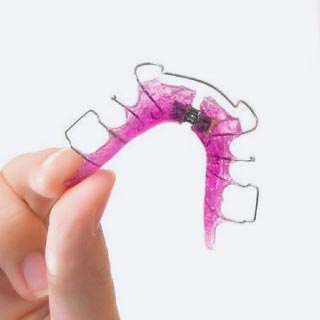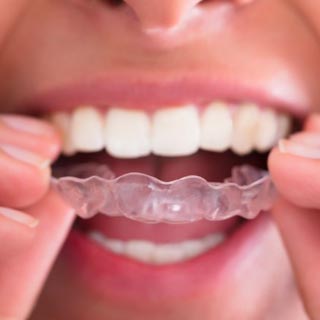

You’ve worked hard for your beautiful smile; keep it that way!
Finally, your braces have been removed and your smile is beautiful, straight, and best of all, metal-free! However, your orthodontic journey isn’t quite completed. To keep your smile looking its best, you’ll have to wear a retainer to preserve and stabilize your results.
They are used after braces treatment to hold teeth in their correct alignment while the surrounding gums, bones, and muscles adjust to the new positioning of your teeth.
TYPES OF RETAINERS
Retainers are custom-made and can be removable or fixed.

Traditional Removable Retainers
typically include a metal wire that surrounds the front teeth and is attached to an acrylic arch that sits on the roof of the mouth. The metal wires can be adjusted to finish treatment and continue minor movement of the front teeth as needed.

Aligner Style Retainers, or Essix Retainers
Look similar to clear aligners and offer a more aesthetic alternative to wire retainers. This clear retainer may fit over the entire arch of your teeth, or only from canine to canine (clip-on retainer). It is produced from a mold of your newly aligned teeth.

Fixed Retainers Lafayette
consist of wires bonded behind the bottom and/or top teeth. While the device is usually required no more than a year after wisdom teeth have been extracted, it is often kept in place for life.
PROS AND CONS
- Removable retainers can be taken out for eating and hygiene routines.
- Removable retainers can get lost easily, so remember to keep yours in the case whenever you remove it to eat or brush.
- A fixed retainer is great if you don’t want to keep track of it, or if you don’t want to worry about how many hours per day it must be worn.
- Teeth with fixed retainers require a little extra attention to remove tartar while flossing. Patients with fixed retainers often must use floss threaders to pass dental floss through the small spaces between the retainer and the teeth.
Frequently Asked Questions
Retainers are an essential part of orthodontic treatment. This orthodontic appliance helps prevent orthodontic relapse and keep your teeth in their newly achieved alignment. All in all, retainers are not an appliance that helps move dental structures but rather prevents undesired movements. Whether you begin using the efficient Essix retainers Lafayette patients wear or other types of retainers, you should know it is not a trivial thing.
Yes. Some people will prefer using the traditional removable retainers Lafayette providers can offer, otherwise known as Hawley retainers, but some people might prefer the Essix type of retainers, especially those who completed their orthodontic treatment with clear aligners. Likewise, an orthodontist might recommend you use a fixed retainer depending on your habits during the main portion of your orthodontic care.
Unlike most well-known orthodontic appliances, orthodontic retainers don’t move teeth into a desired alignment; rather, retainers prevent any unwanted dental movements related to orthodontic relapse. The only reason why orthodontic care is possible is that we can move teeth by applying gentle pressure that dissolves the bone tissue at the base of each tooth. We need time so that the tissue solidifies and secures each piece in its new position, and that’s where retainers come in handy. They prevent teeth from sliding back into the wrong position.
As with any other service or product in orthodontics, you’ll have to come to a consultation with the orthodontist to determine the expected cost of your treatment. Every patient has unique circumstances, meaning that everyone’s treatment considerations will result in varying treatment costs. Also, keep in mind that there are different types of retainers, and the one you choose might be more expensive or more affordable than another chosen by someone else.
Only the best kind. But in all honesty, orthodontists use three common types of retainers to help patients keep their hard-earned results. You may want to take a closer look at Essix retainers, which are very similar in form to the well-known clear aligners, such as Invisalign or Spark. Another type of aligner you should keep on your radar is Hawley retainers, as they are conventional removable retainers everyone is familiar with. Finally, you may want to ask your orthodontist about fixed retainers, which are not as demanding of patients as the other alternatives.
This will highly depend on your choice of retainer. Generally speaking, a set of retainers can last anywhere from three to ten years with proper care. Please remember that it’s essential you develop good hygiene habits surrounding your appliance care and oral health. Keeping your retainers clean and frequently brushing your teeth will help you maintain good dental health and avoid unwanted damage to your orthodontic appliance.


